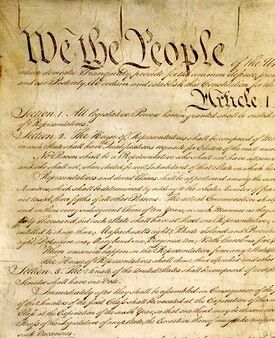Constitutional Law Treatise
Table of Contents
|
|
|
| Constitutional Law Outline
|
| Introduction
|
| The Preamble
|
| Article I Legislative Branch
|
| Art. I, Section 1 Legislative Vesting Clause
|
| Art. I, Section 2 House of Representatives
|
| Art. I, Section 3 Senate
|
| Art. I, Section 4 Congress
|
| Art. I, Section 5 Proceedings
|
| Art. I, Section 6 Rights and Disabilities
|
| Art. I, Section 7 Legislation
|
| Art. I, Section 8 Enumerated Powers
|
| Art. I, Section 9 Powers Denied Congress
|
| Art. I, Section 10 Powers Denied States
|
| Article II Executive Branch
|
| Art. II, Section 1 Function and Selection
|
| Art. II, Section 2 Powers
|
| Art. II, Section 3 Duties
|
| Art. II, Section 4 Impeachment
|
| Article III Judicial Branch
|
| Art. III, Section 1 Vesting Clause
|
| Art. III, Section 2 Justiciability
|
| Art. III, Section 3 Treason
|
| Article IV Relationships Between the States
|
| Art. IV, Section 1 Full Faith and Credit Clause
|
| Art. IV, Section 2 Interstate Comity
|
| Art. IV, Section 3 New States and Federal Property
|
| Art. IV, Section 4 Republican Form of Government
|
| Article V Amending the Constitution
|
| Article VI Supreme Law
|
| Article VII Ratification
|
| First Amendment: Fundamental Freedoms
|
| Religion
|
| Establishment Clause
|
| Free Exercise Clause
|
| Free Speech Clause
|
| Freedom of Association
|
| Second Amendment: Right to Bear Arms
|
| Third Amendment: Quartering Soldiers
|
| Fourth Amendment: Searches and Seizures
|
| Fifth Amendment: Rights of Persons
|
| Sixth Amendment: Rights in Criminal Prosecutions
|
| Seventh Amendment: Civil Trial Rights
|
| Eighth Amendment: Cruel and Unusual Punishment
|
| Ninth Amendment: Unenumerated Rights
|
| Tenth Amendment: Rights Reserved to the States and the People
|
| Eleventh Amendment: Suits Against States
|
| Twelfth Amendment: Election of President
|
| Thirteenth Amendment: Abolition of Slavery
|
| Thirteenth Amend., Section 1 Prohibition on Slavery and Involuntary Servitude
|
| Thirteenth Amend., Section 2 Enforcement
|
| Fourteenth Amendment: Equal Protection and Other Rights
|
| Fourteenth Amend., Section 1 Rights
|
| Fourteenth Amend., Section 2 Apportionment of Representation
|
| Fourteenth Amend., Section 3 Disqualification from Holding Office
|
| Fourteenth Amend., Section 4 Public Debt
|
| Fourteenth Amend., Section 5 Enforcement
|
| Fifteenth Amendment: Right of Citizens to Vote
|
| Fifteenth Amend., Section 1 Right to Vote
|
| Fifteenth Amend., Section 2 Enforcement
|
| Sixteenth Amendment: Income Tax
|
| Seventeenth Amendment: Popular Election of Senators
|
| Eighteenth Amendment: Prohibition of Liquor
|
| Eighteenth Amend., Section 1 Prohibition
|
| Eighteenth Amend., Section 2 Enforcement of Prohibition
|
| Eighteenth Amend., Section 3 Ratification Deadline
|
| Nineteenth Amendment: Women's Suffrage
|
| Twentieth Amendment: Presidential Term and Succession
|
| Twentieth Amend., Section 1 Terms
|
| Twentieth Amend., Section 2 Meetings of Congress
|
| Twentieth Amend., Section 3 Succession
|
| Twentieth Amend., Section 4 Congress and Presidential Succession
|
| Twentieth Amend., Section 5 Effective Date
|
| Twentieth Amend., Section 6 Ratification
|
| Twenty-First Amendment: Repeal of Prohibition
|
| Twenty-First Amend., Section 1 Repeal of Eighteenth Amendment
|
| Twenty-First Amend., Section 2 Importation, Transportation, and Sale of Liquor
|
| Twenty-First Amend., Section 3 Ratification Deadline
|
| Twenty-Second Amendment: Presidential Term Limits
|
| Twenty-Second Amend., Section 1 Limit
|
| Twenty-Second Amend., Section 2 Ratification Deadline
|
| Twenty-Third Amendment: District of Columbia Electors
|
| Twenty-Third Amend., Section 1 Electors
|
| Twenty-Third Amend., Section 2 Enforcement
|
| Twenty-Fourth Amendment: Abolition of Poll Tax
|
| Twenty-Fourth Amend., Section 1 Poll Tax
|
| Twenty-Fourth Amend., Section 2 Enforcement
|
| Twenty-Fifth Amendment: Presidential Vacancy
|
| Twenty-Fifth Amend., Section 1 Presidential Vacancy
|
| Twenty-Fifth Amend., Section 2 Vice President Vacancy
|
| Twenty-Fifth Amend., Section 3 Declaration by President
|
| Twenty-Fifth Amend., Section 4 Declaration by Vice President and Others
|
| Twenty-Sixth Amendment: Reduction of Voting Age
|
| Twenty-Sixth Amend., Section 1 Eighteen Years of Age
|
| Twenty-Sixth Amend., Section 2 Enforcement
|
| Twenty-Seventh Amendment: Congressional Compensation
|
Twenty-Fifth Amendment Presidential Vacancy
The Twenty-Fifth Amendment was an effort to resolve some of the continuing issues revolving about the office of the President; that is, what happens upon the death, removal, or resignation of the President and what is the course to follow if for some reason the President becomes disabled to such a degree that he cannot fulfill his responsibilities. The practice had been well established that the Vice President became President upon the death of the President, as had happened eight times in our history. Presumably, the Vice President would become President upon the removal of the President from office. Whether the Vice President would become acting President when the President became unable to carry on and whether the President could resume his office upon his recovering his ability were two questions that had divided scholars and experts. Also, seven Vice Presidents had died in office and one had resigned, so that for some 20% of United States history there had been no Vice President to step up. But the seemingly most insoluble problem was that of presidential inability--James Garfield's lying in a coma for eighty days before succumbing to the effects of an assassin's bullet, Woodrow Wilson an invalid for the last eighteen months of his term, the result of a stroke--with its unanswered questions: who was to determine the existence of an inability, how was the matter to be handled if the President sought to continue, in what manner should the Vice President act, would he be acting President or President, what was to happen if the President recovered. Congress finally proposed this Amendment to the states in the aftermath of President John F. Kennedy's assassination, with the Vice Presidency vacant and a President who had previously had a heart attack.
The Amendment was invoked during the 1970s and resulted for the first time in our history in the accession to the Presidency and Vice-Presidency of two men who had not faced the voters in a national election. First, Vice President Spiro Agnew resigned on October 10, 1973, and President Richard M. Nixon nominated Gerald R. Ford to succeed him, following the procedures of § 2 of the Amendment for the first time. Hearings were held upon the nomination by the Senate Rules Committee and the House Judiciary Committee, both Houses thereafter confirmed the nomination, and the new Vice President took the oath of office December 6, 1973. Second, President Nixon resigned his office August 9, 1974, and Vice President Ford immediately succeeded to the office and took the presidential oath of office at noon of the same day. Third, again following Section 2 of the Amendment, President Ford nominated Nelson A. Rockefeller to be Vice President; on August 20, 1974, hearings were held in both Houses, confirmation voted, and Rockefeller took the oath of office December 19, 1974.[1]
Section 1 Presidential Vacancy[edit | edit source]
- Main Article
| Clause Text
|
| In case of the removal of the President from office or of his death or resignation, the Vice President shall become President.
|
Section 2 Vice President Vacancy[edit | edit source]
- Main Article
| Clause Text
|
| Whenever there is a vacancy in the office of the Vice President, the President shall nominate a Vice President who shall take office upon confirmation by a majority vote of both Houses of Congress.
|
Section 3 Declaration by President[edit | edit source]
- Main Article
| Clause Text
|
| Whenever the President transmits to the President pro tempore of the Senate and the Speaker of the House of Representatives his written declaration that he is unable to discharge the powers and duties of his office, and until he transmits to them a written declaration to the contrary, such powers and duties shall be discharged by the Vice President as Acting President.
|
Section 4 Declaration by Vice President and Others[edit | edit source]
- Main Article
| Clause Text
|
| Whenever the Vice President and a majority of either the principal officers of the executive departments or of such other body as Congress may by law provide, transmit to the President pro tempore of the Senate and the Speaker of the House of Representatives their written declaration that the President is unable to discharge the powers and duties of his office, the Vice President shall immediately assume the powers and duties of the office as Acting President.Thereafter, when the President transmits to the President pro tempore of the Senate and the Speaker of the House of Representatives his written declaration that no inability exists, he shall resume the powers and duties of his office unless the Vice President and a majority of either the principal officers of the executive department or of such other body as Congress may by law provide, transmit within four days to the President pro tempore of the Senate and the Speaker of the House of Representatives their written declaration that the President is unable to discharge the powers and duties of his office. Thereupon Congress shall decide the issue, assembling within forty-eight hours for that purpose if not in session. If the Congress, within twenty-one days after receipt of the latter written declaration, or, if Congress is not in session, within twenty-one days after Congress is required to assemble, determines by two-thirds vote of both Houses that the President is unable to discharge the powers and duties of his office, the Vice President shall continue to discharge the same as Acting President; otherwise, the President shall resume the powers and duties of his office.
|
- ↑ For the legislative history, see S. Rep. No. 66, 89th Cong., 1st Sess. (1965); H.R. Rep. No. 203, 89th Cong., 1st Sess. (1965); H.R. Rep. No. 564, 89th Cong., 1st Sess. (1965). For an account of the history of the succession problem, see R. Silva, Presidential Succession (1951).



